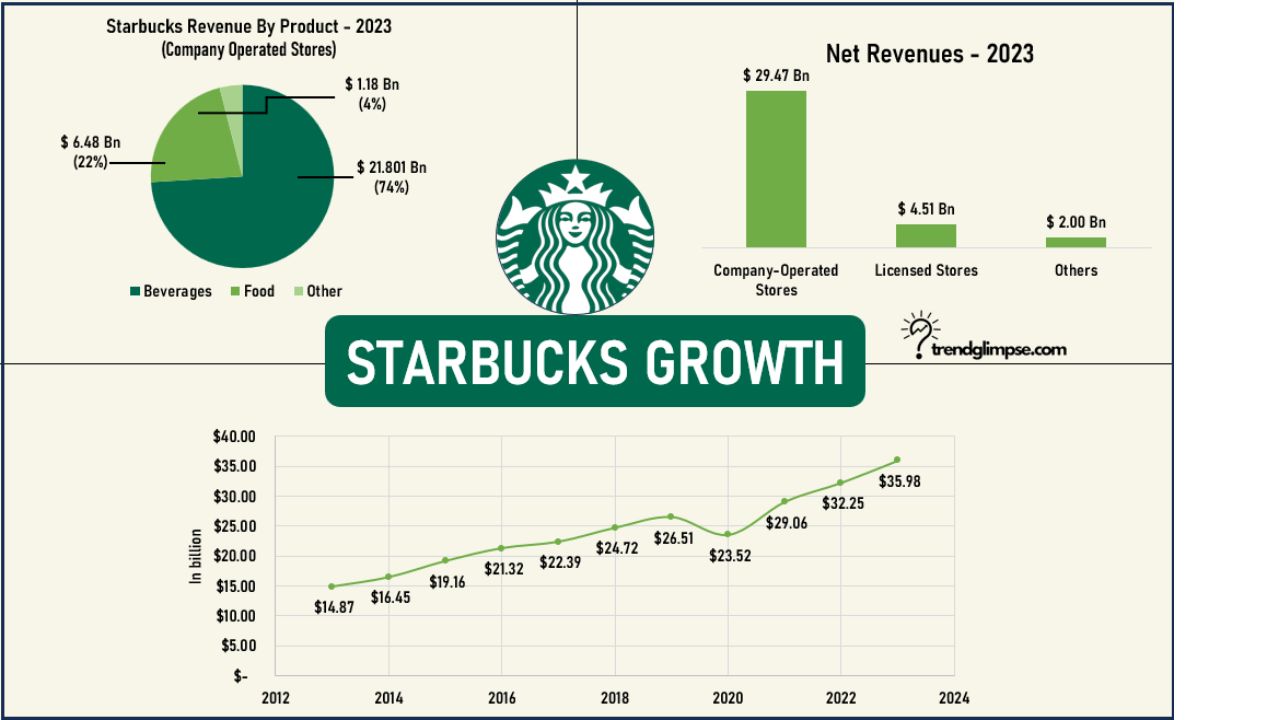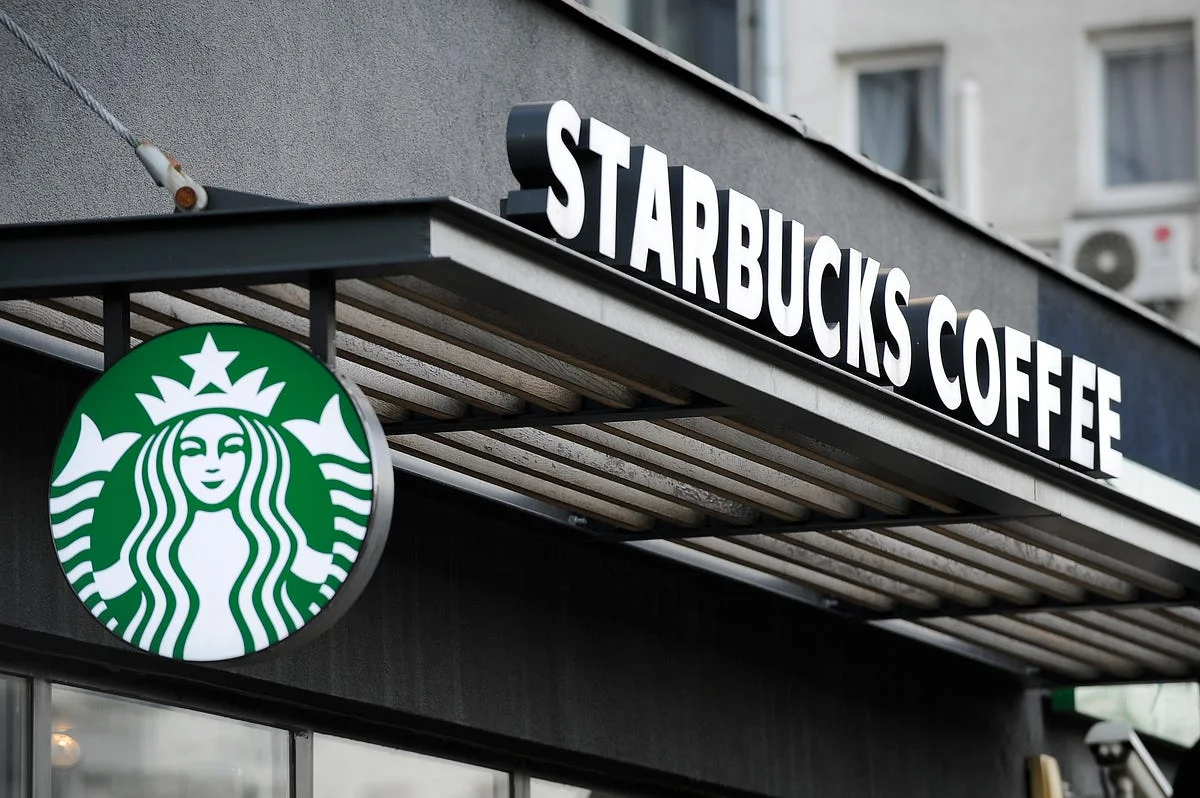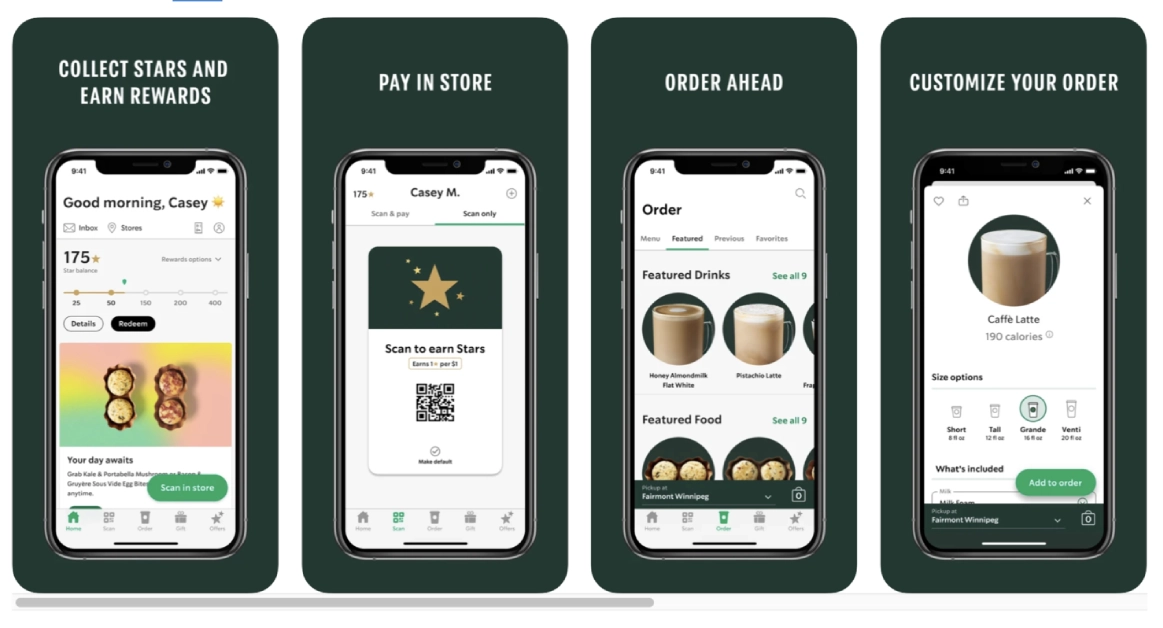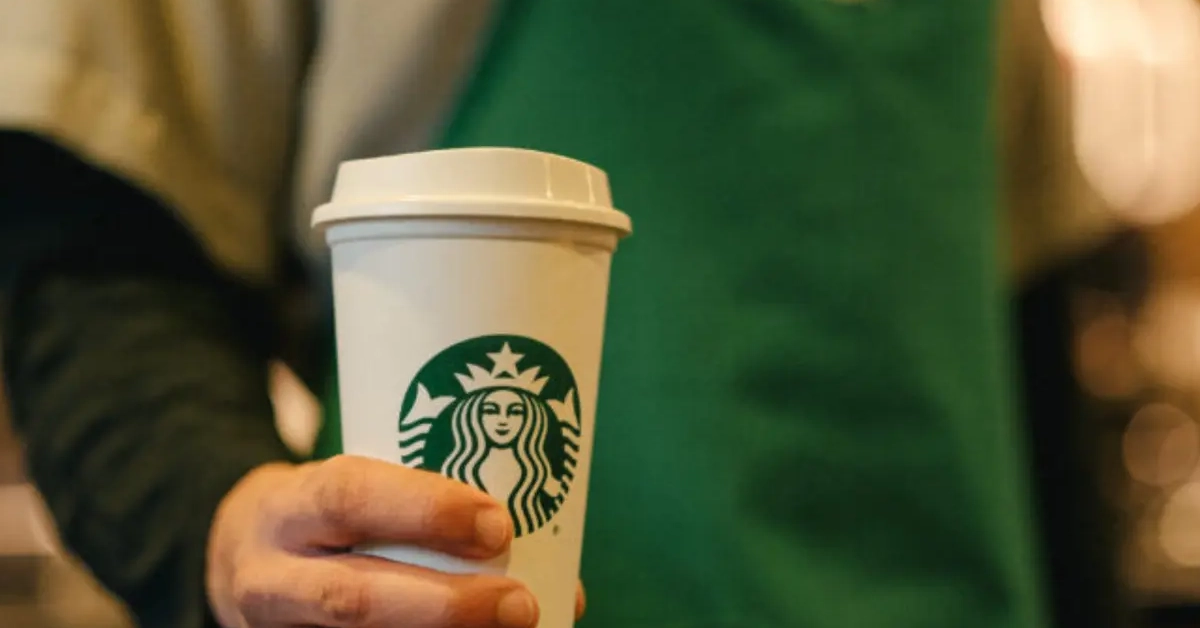What is Starbucks?
It’s nearly impossible to walk a city block without spotting that familiar green and white logo beckoning you to step inside. With over 35,000 stores across the globe, Starbucks cafés have become go-to neighbourhood spots to grab your morning joe or meet up with friends.
Headquarters: Starbucks Center, Seattle, Washington, United States
Industry: Coffeehouses and Roastery Reserves
Current CEO: Laxman Narasimhan
Annual Revenue [2023]: US$ 35.97 Billion
Employee Count: ~ 402,000
Website: Starbucks.com
In 2023 alone, Starbucks generated $35.97 billion in revenue, an impressive 11.55% increase over the prior year even in light of pandemic conditions affecting sales. Starbucks has delivered consistent revenue increases for years, driven by a formula that skillfully combines physical and digital customer engagement paired with creative offerings.
With knowledgeable baristas crafting handmade drinks, soothing music playing in the background, and the aroma of freshly-brewed coffee lingering in the air, Starbucks has perfected an inviting café environment that feels like a home away from home for millions of loyal customers.
Drinks (Hot Coffees, Cold Coffees, Oleato™, Hot Teas, Frappuccino® Hot Drinks, Blended Beverages, Iced Teas, Cold Drinks), Food (Hot Breakfast, Oatmeal & Yogurt, Bakery, Lunch, Snacks & Sweets), At Home Coffee (Whole Bean, Ground, VIA® Instant), Merchandise( Cold Cups, Tumblers, Mugs, Other)
Competitors of Starbucks
Dunkin’, McDonald’s McCafé, Costa Coffee, Peet’s Coffee, Tim Hortons, Caffè Nero, Caribou Coffee, The Coffee Bean & Tea Leaf, Gloria Jean’s Coffees, Panera Bread, Dutch Bros Coffee, Second Cup, Lavazza, Tully’s Coffee
This article will provide an in-depth look at Starbucks’ business model from product differentiation to its global expansion strategy and how it has set them apart from competitors. We’ll learn how the Starbucks business model has brewed up huge success for the coffee giant.
Starbucks Business Model Canvas
How Does Starbucks Generates Revenue

Beverage & Food Sales
It’s no secret that the bulk of Starbucks’ impressive revenue stems from ongoing beverage and food sales from customer traffic into its 35,000 company-owned and licensed stores globally. Signature handcrafted drinks like lattes, cold brews, and Frappuccinos account for almost half of sales alone thanks to their premium pricing. Surprisingly, food items like breakfast sandwiches, protein boxes, and pastries make up a growing portion as Starbucks expands into more lunch and snacking options. Regular customers visiting even just a few times per week quickly rack up receipts.
Whole Bean Coffee Sales
While less recognized, whole bean coffee bag sales represent a significant portion of revenue. Coffee purists and aspiring home baristas stock up on Starbucks signature roasts like Pike Place, French Roast, or seasonal blends to brew at home. Being able to purchase the same quality beans used in stores builds brand loyalty.
Branded Merchandise Sales
Capitalizing on its powerful branding, Starbucks also sells a variety of logo merch including coffee mugs, tumblers, gift cards and more. Limited-edition city, holiday, or designer collections in particular cause a buying frenzy and sell out quickly thanks to FOMO.
Licensed Store Royalty Fees
An additional solid stream of income flows in from royalty and licensing fees paid by grocery chains, hotels, airports and other retailers that operate Starbucks shops globally. The average cost to license a Starbucks store is around $315,000, and a licensee must have over $1,000,000 in liquid assets to be considered. Providing pre-packaged and bottled beverages gives the brand huge exposure outside company-owned locations as well.
Ready-to-Drink Beverages
Speaking of, ready-to-drink Frappuccinos, chilled brews, and espresso shots are popular. Starbucks is a leading ready-to-drink (RTD) coffee brand in the United States, with sales amounting to over $377 million in the 52 weeks ended May 15, 2022. In the last quarter of 2023, cold drinks made up 75% of Starbucks’ US beverage sales, and cold espresso drinks in particular rose 13% from a year ago. As coverage expands, so will lucrative licensing deals.
Subscription Services
Starbucks can benefit from turning customers into subscribers by getting to know their customers better, creating a recurring revenue model, and improving customer loyalty. Starbucks Rewards, a loyalty program, allows customers to earn stars and get rewarded for their purchases. Starbucks Reserve Roastery Subscription program, which was launched in 2015, allowed customers access to unique, small-lot coffees only available at the Roastery or through the subscription.

How Starbucks Drives Its Value Proposition
Signature Coffee Aroma & Taste
Starbucks built a multi-billion dollar empire by delivering an irreplaceable aromatic coffee experience starting with responsibly sourced beans roasted to perfection for a smooth, well-balanced flavor distinguished by nutty, caramel notes in every sip. Customers can’t resist the trademark aroma wafting through doors. Small indulgences in signature drinks made just for you lift moods during everyday moments.
Customizable Beverage Menu
Of course, complete personalization empowers customers to tailor each beverage to satisfy individual tastes down to milk type, sweetness and temperature. With over 87,000 possible drink combinations now and innovations like plant-based milks or cold foam, Starbucks caters to diverse preferences. Thoughtful choices and customization reveal our identities. They are also responding to growing customer interest in plant-based foods by introducing oatmilk in all U.S. stores in Spring 2021. Starbucks continues to add plant-based drinks and food globally, aligning with the industry’s rapid growth, which has increased by 29% over the past two years.
Sustainable Coffee Practices
Starbucks has donated nearly 50 million coffee trees resistant to rust diseases, supporting a 10-year, 100 million tree commitment. Moreover Starbucks increases its Global Farmer Fund to $100 million, providing funds for coffee growers to enhance farm productivity and sustainability. Moreover Starbucks commits to the Dairy Net Zero Initiative, seeking net zero greenhouse gas emissions and improved water quality on farms in its supply chain.
Cozy Store Atmosphere
Cozy ambient lighting, comfy seats, soft music and artisan touches transform sterile spaces into relaxing havens where friends reconnect and ideas flow freely. Fast wifi and ample outlets welcome remote work without isolation. Regulars find community as baristas call them by name with a welcoming smile. Uplifting third spaces build a loyal, feel-good following.
Knowledgeable Baristas
Speaking of baristas, intensive training on the methodology, science and art behind each cup allows them to expertly craft quality beverages at speed while providing gracious hospitality even on hectic days. Genuine customer conversations foster surprise and delight moments through small acts of kindness or extra personalization.
Rewarding Loyalty Program
Starbucks Rewards members earn free signature drinks and food just by making daily purchases they would already splurge on. Exclusive promotions and challenges keep engagement fun while surprise bonus stars and birthday treats delight patrons. Building emotionally rewarding experiences nurtures customer loyalty and habit-forming daily rituals.
Understanding Starbucks Diverse Customer Base
Multi-Generational Appeal
Starbucks has become a comfortable gathering place for everyone from university students to retirees. By offering calm, elegant stores with free wifi and power outlets, they enable socialization, studying, and work. My local Starbucks has teens doing homework, millennials networking, and baby boomers reading the paper.
Status And Peer Influence
Another aspect is status and peer influence. Starbucks has effectively marketed itself as an affordable luxury, a little treat amid everyday life. Let’s be honest, that $6 latte isn’t just about the quality coffee. People are buying a lifestyle and a visible brand that confers a certain status. Drinking that fancy Starbucks coffee makes people feel sophisticated while fitting in with peers and colleagues who frequent the cafes. Especially among younger consumers, the brand has tremendous cachet.
On-The-Go Urbanite
Starbucks also draws in the always-moving urbanite customer base. With locations on practically every city corner, Starbucks fits seamlessly into hectic metropolitan lifestyles. The stores offer convenience for professionals who want a quick breakfast or afternoon caffeine fix. City dwellers can pop in, grab their drink orders, connect to wifi if needed, and carry on with their busy days. For the urban workforce rushing to meetings and appointments, Starbucks’ speed, reliability, and ubiquity is the perfect formula.
Busy Professional
Starbucks appeals tremendously to busy suburban professionals and families. The stores’ familiar environment, predictable menu offerings, and rapid service help harried office workers, minivan drivers, and soccer moms get a short sensory respite. Whether as a morning ritual or a hard-earned weekend treat for the whole family, Starbucks’ welcoming refuge from hectic everyday life keeps customers coming back again and again across generations and lifestyles.

Various Channels Used by Starbucks
In-Store Branding & Display
Walking into any Starbucks, customers are immersed in tasteful in-store branding and attractive product displays that catch the eye. Menu boards highlight seasonal beverage offerings and showcase tempting food items like pastries, sandwiches, oatmeal and snack boxes. Moreover starbucks uses in-store signage not just for customers but also to inform and inspire employees. Strategically placed impulse purchase items like signature coffee mugs, coffee beans, and Starbucks gift cards encourage additional sales. The vibrant and consistent in-store aesthetic helps make customers feel welcomed while promoting new and best-selling products.
Mobile App
Starbucks’ user-friendly mobile app accounts for a remarkable 25% of total transactions. Customers can fully customize and preorder their go-to drinks so they are ready for pickup. Frequent buyers take advantage of mobile ordering and accrue Stars towards free rewards at a faster rate with the app – very appealing! Starbucks sends helpful app reminders on birthdays or when accumulated Stars are about close to expiration. These prompts keep customers engaged.
Social Media
On social media, Starbucks spotlights community outreach efforts and uses fun memes or polls to interact with followers. Customers visiting local stores may receive surprise social media shoutouts along with photos holding their favorite drinks, further promoting that welcoming Starbucks culture. This sense of community and connection resonates with many.
TV & Web Commercials
You can frequently find Starbucks TV commercials and web advertisements focused on spreading seasonal cheer or bringing people together over coffee and meaningful conversations. Many ads highlight Starbucks’ ethical sourcing initiatives as well – educating consumers while encouraging them to “Be a Force for Good” by purchasing Starbucks products.
Product Placement
Starbucks implements noticeable product placement across all forms of media – TV shows, films, songs, books and more. Characters may be depicted holding Starbucks cups with familiar branding or meeting in a Starbucks location. This organic marketing makes Starbucks part of pop culture and embeds their brand in consumers’ minds. Partnering with brands that share similar values also allows Starbucks to connect with targeted demographics.
Art of Customer Engagement at Starbucks
Friendly In-Store Service
Starbucks has practically turned customer engagement into an art form! The friendly in-store service starts each interaction off on the right foot as soon as you walk through the doors. Baristas go out of their way to make personal connections, ask you how your day is going, and ensure you leave satisfied. I’ve had some heartwarming conversations with my regular baristas. Their ability to remember customers’ names and orders makes people feel genuinely cared for.
Personalized Mobile App
The Starbucks mobile app drives personalization and convenience while rewarding loyalty. Customers can access a seamless ordering experience, accrual of Stars towards free beverages and food items, and even the ability to pay in-store directly from their phones. Starbucks enhances engagement through surprise Stars gifts, special birthday offers, and order suggestions based on your previous purchases.
Social Media Contests & Content
On social media, Starbucks constantly runs creative contests to drive likes, comments, and shares while sparking fun customer participation both online and in stores. Clever polls and coffee-inspired memes make followers laugh while promoting products. Social media spotlights inspiring acts of kindness from store partners which boosts customer pride.
Targeted Promotions
Starbucks leverages customer data from its robust loyalty program to provide targeted promotions through email and app messaging. Offers like “happy Monday! enjoy 50% off a macchiato today,” Free Drinks challenges, and redemption periods for free gifts incentivize customers to purchase again soon. These timely nudges are tactical and effective.
Local Community Building
Starbucks build local community connections through fundraising events that support causes customers care about – from sustainability to foster youth programs. Partnering with local artists and non-profits also demonstrates their commitment to neighborhoods they serve. This community immersion attracts new customers who align values while retaining existing ones. Moreover, Starbucks Community Resilience Fund committed $100M to advance racial equity and environmental resilience.

Core Ingredients of Starbucks Success
Talented Baristas
Talented, well-trained baristas are one of Starbucks’ most valuable assets. They expertly handcraft customized drinks to exact specifications and make meaningful emotional connections with customers to drive loyalty and repeat business. Extensive training prepares baristas to master recipes, manage high volume throughput, and deliver exceptional service with a smile despite back-to-back shifts. With average employee tenure double other retail sectors, baristas get to know local patrons personally.
Real Estate Assets
Prime real estate holdings in high-traffic areas like college campuses, malls, office plazas and beyond provide access to core demographics locally and globally in key growth regions like China. Store designs showcase local elements reflecting neighborhood vibe and history to help customers feel at home. Recent investments into modernized café formats with expansive patios, open floorplans, and Mixed-use community spaces boost brand exposure.
Logistics Infrastructure
Sophisticated supply chain logistics ensure essential ingredients like dairy, produce, and packaged goods reach global store locations safely and consistently twice per week to preserve freshness and meet demand. State-of-the-art roasting facilities and distribution networks spanning six continents underpin reliable and efficient operations at scale. Adaptability throughout the pandemic enabled continuity despite disruptions.
Coffee Supply Chain
Ethically and sustainably sourced high-quality Arabica coffee beans obtained through collaborative farmer relationships fuel product quality and integrity. Starbucks purchases about 3% of the world’s coffee, supporting over 400,000 farmers in 30 countries. Protecting long-term supply availability enables Starbucks to rapidly expand its footprint without sacrificing consumer trust or operational control. Ownership stakes in strategic international mills and plantations safeguard sourcing stability as demand escalates.
Brand Authority
Ultimately Starbucks’ brand authority as an industry trailblazer and game-changer cements loyalty even amid competitor saturation. By taking bold stances on social issues aligned with company values like sustainability, fair employment practices and community building, Starbucks maintains cultural relevance with key consumer segments who identify with the brand on a deeper level – driving enduring equity beyond just coffee quality.
Starbucks’ Keys to Crafting Café Success
Sourcing Premium Coffee
The magic starts with sourcing only the top 1-2% of premium Arabica coffee beans from sustainable farms spanning Latin America, Africa and Asia. Establishing direct relationships and reasonable prices for farmers fosters Starbucks’ reliability as a leading global purchaser. Supporting agronomy research and open-source sharing of IP benefits all links in the supply chain long-term for quality and yield gains.
Roasting & Blending
Skilled Starbucks roast masters meticulously blend sourced beans to the company’s exacting flavor profiles. The custom combination of roasting temperatures, techniques and timing unlock each coffee’s most vibrant characteristics and balance. Seasonal small-batch blends keep offerings exciting. State-of-the-art automated roasting reduces variability for consistent delivery across massive volumes.
New Beverage Innovation
Starbucks built its empire on beverage innovation – being the first to bring high-end espresso and handcrafted coffee to the masses. But customer tastes evolve so Starbucks relentlessly trials new creations in its “Liquid Lab” testing futuristic ingredients, preparation methods and customization opportunities years in advance. Winning launches like nitro cold brews, plant-based milks, and Instagrammable Frapp flavors propel growth.
Customer Experience Design
Thoughtful customer experience design considerations span every touchpoint from store aesthetics to mobile app convenience. Tracking customer data and perspectives allows Starbucks to optimize experiences to suit emerging trends from sustainability to mobile pre-ordering. Stores transform into welcoming “third-places” between work and home for connection over quality coffee, backed by speedy service even during rush hour.
Store Operations
Store operations run like well-oiled machines thanks to diligent workforce planning and continual process improvements. Sharing best practices across regions helps struggling locations course correct quickly. Employee empowerment to resolve complaints and personalized barista training cultivates in-store excellence. For Starbucks, the “how” matters as much as the “what” when crafting café success.
Essential Partnerships that Elevate Starbucks
Dairy & Ingredient Suppliers
Reliable, large-scale dairy and ingredient suppliers enable Starbucks to consistently source and stock high-volume essentials like milk, vanilla, chocolate and custom syrups in thousands of stores for uninterrupted operations. These suppliers co-invest in sustainable sourcing and streamlined supply chains to ensure fresh, high-quality inputs for signature drinks even amid volatile commodity markets.
Mobile & Cashless Payments
Innovative partnerships with mobile payment platforms like Apple Pay, Google Pay and PayPal transformed Starbucks into an industry leader for cashless, contactless purchasing – even rewarding mobile app users more aggressively. Frictionless payments represent 25% of orders now, up from 16% in 2020, providing invaluable customer data and faster throughput while improving convenience and safety.
Grocery Distribution
Lucrative grocery distribution pacts expanded packaged, bottled and single-serve Starbucks offerings into leading chains like Target, Walmart, and Costco along with hotels, airports and offices – capturing new audiences beyond café storefronts in a win-win. Household penetration lifts brand affinity even for infrequent purchasers.
Music & Entertainment
Music and entertainment collaborations with emerging and established artists, films, streaming platforms and record labels further boosted engagement and sales especially amongst younger demographics. Catchy tunes featured in commercials got stuck in people’s heads while driving streams. Prominent product placement built cultural relevance.
Co-Branding Initiatives
Co-branded credit cards, merchandise collections, content series and experiential events with partners like Chase Bank, Spotify and Unicef allow both brands to align values in sustainability, ethics and inclusion while expanding reach. These mission-driven partnerships can unlock PR and employee goodwill boosting corporate reputation as well.
How Starbucks Covers Operational Expenses
Cost of Goods Sold
Handcrafting 50+ million customized drinks weekly requires costly ingredients like milk, coffee beans, flavor syrups and toppings, packaging and more. These account for Starbucks’ largest expense at over 30% of revenue as the cost of goods sold. Strategic long-term supplier contracts, commodity hedging and operational efficiencies help maximize profit margins per unit while ensuring supply reliability.
Occupancy Costs
With massive global real estate holdings for openings and renovations, occupancy costs like rent, utilities, maintenance, and facilities management require nearly 15% of earnings. Prioritizing prime high traffic locations in urban markets and transportation hubs boosts foot traffic despite higher rents. Design investments enhance the in-store 3rd space experience as well.
Store Operations Payroll
In retail, labor represents a major cost and Starbucks invests heavily in competitive wages, benefits packages and ongoing barista training for its 383,000+ employees to maximize hospitality and minimize turnover expenses. Still this single budget line item totals nearly 20% given extended operating hours and service delivery across 32,000 locations.
New Store Development
Speaking of, simply constructing beautifully designed new stores costs over a billion dollars annually from planning, permits, equipment and technology costs. But expanding into promising international and domestic markets promises lucrative returns over time. Flagship Reserve Roastery cafes also spotlight premium brand heritage.
Marketing & Technology
Building emotional customer connections through multi-channel marketing and innovative ordering platforms demands constant innovation and strategic digital, print, social media and TV commercial investments. Campaigns highlighting ethical sourcing and community give back resonate strongly with loyal patrons.
Administration Overhead
Administrative overhead stemming from executive leadership, global business operations, real estate management and back office systems amount to 25% of costs. But strong financial governance and analytics maximize profitability over the long run.
Supply Chain Management
Finally, distribution logistics, inventory management and warehousing represent additional supply chain costs to coordinate farmers, roasting, distributors and thousands of retail outlets – smoothed by scale economies and centralized technology hubs.
Starbucks Competitors
Dunkin’
Dunkin’ offers a more affordable coffee option compared to Starbucks, appealing to value-conscious customers. With over 12,600 locations globally, Dunkin’ specializes in donuts but has been expanding its beverage menu to better compete with Starbucks. While Dunkin’ lags behind in premium offerings, it stands out for speed of service and simplicity. By targeting busy commuters with an efficient in-and-out experience, Dunkin’ competes for different usage occasions than the “third place” atmosphere Starbucks cultivates.
Costa Coffee
Costa Coffee, owned by The Coca-Cola Company since 2019, has over 4,000 stores in the UK and a growing presence in Asian markets. As the second-largest coffee chain in the world, Costa differentiates with emphasis on food options including savory breakfasts, sandwiches, and pastries. Costa positions itself as a step above mass market brands but below premium chains like Starbucks, based on elements such as sourcing and sustainability practices. Costa has significant room to grow in the US market as a challenger brand to Starbucks.
Tim Hortons
Tim Hortons is the Canadian market leader in coffee and donuts, with around 5,000 locations across the country. While it has a small presence in the US, Tim’s competitiveness is based on a national identity as a no-frills coffee spot offering familiar comfort foods. Its Iced Capp drinks also fill a niche not served by typical US chains. An opportunity for Tim Hortons would be focusing on colder US regions or near Canadian border crossings.
Peet’s Coffee
Peet’s Coffee, a San Francisco Bay area original now owned by JAB Holding Company, operates over 200 locations in the US. Positioned as more specialized upmarket coffee chain than Starbucks, Peet’s has invested heavily in technology such as carbon dioxide decaffeination to differentiate quality. However, Peet’s limited scale poses challenges for competing directly against the dominant Starbucks brand. Prioritizing a refined store experience over rapid expansion may enable Peet’s to cultivate cafe loyalty in select markets.
McDonald’s McCafé
McDonald’s, while better known for burgers and fries, has made coffee a growing priority since introducing its McCafé concept in 2009. With strong emphasis on drive-thrus, McDonald’s now rivals Starbucks in US coffee sales by focusing on value, convenience, and speed of service. By improving quality and variety of its coffee, notably with specialty drinks, McDonald’s presents an uprising challenge to Starbucks in the quick-serve and value market segments going forward.
Future Growth Strategies
Looking ahead, Starbucks has tremendous opportunity to continue growing within the framework of its successful business model. Trends like customization and mobile ordering are right in Starbucks’ wheelhouse to capitalize on. They’re already expanding their custom drink options but have room to provide even more innovative combinations through an enhanced app.
Starbucks could also release more limited-edition drinks and food items to generate buzz and drive social sharing. Additionally, they can lean into sustainability with greener store designs and reusable packaging to attract eco-minded consumers. Drone delivery promises to take convenience to the next level too. And Starbucks still has enormous global headroom, especially in emerging Asian and African markets where coffee culture is booming.
By continuing to elevate the Starbucks Experience with the latest technologies and customer-centric strategies, they can reinforce their premium, aspirational brand image that the Starbucks business model has been built on. The future looks bright indeed over a nice Venti iced latte.

I have always been fascinated by the inner workings of companies and industries. So I decided to study business to explore it more. My goal is to take all my research and turn it into cool stories that give people a better understanding of the business world.

